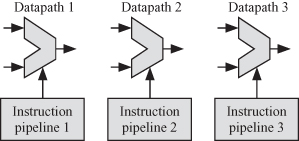2.7 INSTRUCTION-LEVEL PARALLELISM (ILP) AND SUPERSCALAR PROCESSORS
A superscalar processor is able to simultaneously execute several instructions from independent instruction pipelines [18]. Superscalar processors have a dynamic scheduler that examines the instructions in the instruction cache/memory and decides which ones to be issued to each instruction pipeline. Dynamic scheduling allows out-of-order instruction issue and execution. Figure 2.17 shows a general organization of a three-way superscalar processor where the processor contains three instruction pipelines operating on three independent datapath units. A superscalar computer has several instruction pipelines and datapath units that can work in parallel to execute instructions issued to them from the CPU. Using this technique, the instruction execution rate will be greater than the clock rate. For a three-way superscalar architecture with an instruction pipeline, up to three instructions could be executed per clock cycle.
Figure 2.17 General organization of a three-way superscalar processor.

The instruction pipeline for a two-way superscalar processor shown in Fig. 2.18, which is a modification of Fig. 2.14, indicates the fact that we now have two instruction pipelines.
Figure 2.18 Instruction pipelines for a two-way superscalar processor.
At this point, it is worthwhile to explain the difference between VLIW and ...
Get Algorithms and Parallel Computing now with the O’Reilly learning platform.
O’Reilly members experience books, live events, courses curated by job role, and more from O’Reilly and nearly 200 top publishers.

